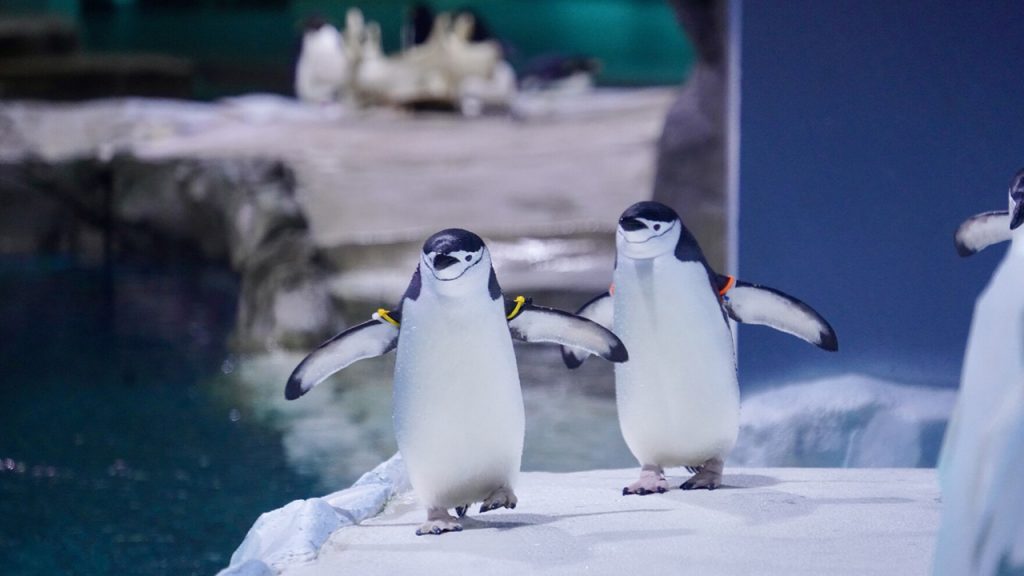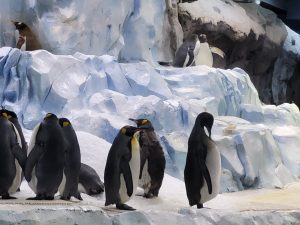Detroit Zoo’s penguins waddle back to exhibit after a two-year closure
The state-of-the-art conservation center debuted in 2016. It has a 25-foot deep diving pool surrounded by massive artificial cliffs, snow makers and even a Jacuzzi-like machine that makes bubbles for the penguins to play in.

More than 75 penguins call the Detroit Zoo's Polk Penguin Conservation Center home. Photo credit: Detroit Zoo
When you first enter the Polk Penguin Conservation Center, you’ll see a huge window looking into the South American area of the enclosure.
On the other side of the glass are groups of one-and-a-half feet tall rockhopper penguins waddling around.
You might notice a tuxedoed gentoo swimming and rocketing out of the water, like a dolphin.
Or a macaroni, sporting yellow feathers on its head, might come up to the glass to examine you, as if you’re the one on display.
These little birds eat over 80 pounds of fish a day. And there’s one other thing that can’t be avoided when taking care of the more than 75 penguins here.
“The cleaning …That’s the hardest part of any zookeeper’s job really but it’s necessary,” says Lindsay Ireland. She’s a member of the animal care staff who has been working with the zoo’s penguins for about 15 years.
“My favorite species would be the macaronis. They’re just very, very curious and always want to know what you’re doing. I would say they’re the friendliest species that we have,” she says.
There are also Kings and two pairs of chinstrap penguins.

The Detroit Zoo opened one of the world’s first indoor penguin exhibits, the Penguinarium, more than 50 years ago.
This new state-of-the-art conservation center debuted in 2016. It has a 25-foot deep diving pool surrounded by massive artificial cliffs, snow makers and even a Jacuzzi-like machine that makes bubbles for the penguins to play in.
“Our habitat here is wonderful them for them,” says Jessica Jozwiak, the bird department supervisor. “We can I think it really brings out a lot of their natural behavior.”
Zoo visitors are also able to get a rare view of the penguins swimming underwater in tunnels below the main exhibit.
“Even though I’ve watched a lot of it in my years that I’ve been here, I never get tired of watching them,” Jozwiak says. “And you know, I’m always learning something new. And certainly, you know, the underwater views here are just spectacular.”
It’s been two years since the center closed to the public due to faulty waterproofing. During repairs, the penguins were moved over to their old exhibit. But with the new facility now reopened, it hasn’t taken long for them to readjust.
“They just kind of fit right in. I mean they were familiar with it. So they just kind of went about their normal business,” Jozwiak says.

And that’s especially important because it’s the start of breeding season for the birds. All of the species except the Kings build nests where they’ll pair up and lay their eggs.
Here we give them their like river rocks and they pick those up and put those in their nest
And building nests is serious business. In the middle of the exhibit, a Gentoo searches for the perfect rock. It closely inspects three different stones before making its choice and making a break back to its nesting site.
On the other side of the enclosure, the 3-foot tall King penguins are beginning to molt. After that, they’ll find a mate and lay eggs, keeping them warm on their feet.
You might wonder if the animal care staff can tell all the birds apart. For the most part, yes, but they also have bands on their flippers to identify them.
And there’s at least one that sticks out from the rest.

Ireland points out Russell, a King penguin.
“He’s got his like, upper half is black, where it should be yellow,” Ireland says. “And he is still he’s young. He’s still acts very much like a chick. He still whistles and like kind of begs at all the other birds and us like a chick.”
The animal care staff gets to know the penguins for years, Jozwiak has spent three decades with these birds.
“They really do have all their own personalities. You know, some are more outgoing. Some are more people-focused, some are more curious,” she says.
Years ago, Ireland returned from maternity leave. She remembers being greeted by a penguin named Mabel.
“She came running up to me screaming, it was like she missed me,” she says. “I know, I’m being anthropomorphic. But it really did seem like you know, she wanted to kind of hang out with me. You know, she was wondering where I was.”
Now that the birds are resettled, Ireland says staff are focused on what they call the “soap opera” of breeding season. And soon enough, new chicks will join the colony.
Trusted, accurate, up-to-date.
WDET strives to make our journalism accessible to everyone. As a public media institution, we maintain our journalistic integrity through independent support from readers like you. If you value WDET as your source of news, music and conversation, please make a gift today.
